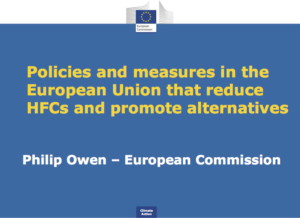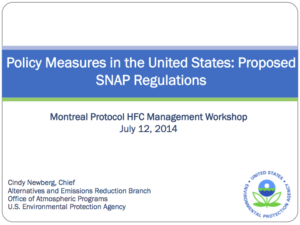Paris Montreal Protocol conference: HFC Management Workshop presentations
- PostedPublished 9 October 2014
A number of presentations were made to an HFC Management Workshop that took place during the 25th Meeting of the Parties to the Montreal Protocol on Substances that Deplete the Ozone Layer, which was hosted in Paris by the United Nations Environment Programme (UNEP) in July.
Topics covered technical, legal and policy issues, plus scientific impacts related to the proposed global phase-down of HFCs under the Montreal Protocol.
Lambert Kuijpers from UNEP’s Technology and Economic Assessment Panel opened the workshop with a session on worldwide demand for HFCs, recognising that data on HFC emissions to atmosphere is far from complete.

HFC demand in Non-Article 5 (developed) countries grew 10-12 per cent each year between 2001 and 2011 but estimated to slow to 1-3 per cent between 2012 and 2014 while Article 5 (developing) countries have experienced 30 per cent annual HFC demand growth between 2001 and 2011, slowing to less than 20 per cent between 2012 and 2014.
Worldwide annual production capacity for R134a, R125 and R32 is around 750,000 tonnes, with around 150,000 tonnes of other HFCs also produced each year.
China, an Article 5 country, is the world’s main production source of HFCs, while Non-Article 5 countries account for around 220,000-240,000 tonnes of worldwide production.
Chandra Bhushan from the Centre for Science and Environment in India revealed some startling projections on how emissions from the subcontinent’s building sector will skyrocket by 2030, with 25 per cent of that output coming from refrigeration and air conditioning.

With 80 per cent of those emissions coming from energy consumption and just 20 per cent from direct HFC emissions, Mr Bhushan highlighted the need to address energy efficiency.
He described a “leapfrog deal” for Article 5 countries in which they agree to freeze HFC consumption at the level of a certain year, with each country negotiating its own HFC phase-down schedule and time limited exemptions of some sectors from the HCFC phase-out where non-HFC alternatives are not available.
Mr Bhushan said this would “galvanise” markets and research towards finding non-HFC and other not-in-kind technologies such as solar cooling, district heating/cooling, heat pumps and absorbtion cooling.
He concluded that the HFC phase-down should be a means to achieve overall greenhouse gas emissions and not just an end in itself and that an increased in funding ($US 3.5 billion a year by 2030) and technology transfer is essential to achieve the energy efficiency and technological advances necessary to make meaningful reductions in greenhouse gas emissions.
Moving on from the greenhouse gas topic, Mr Bhushan warned of possible side-effects cause by the adoption of HFOs, such as increased levels of persistent pollutants like trifluorocetic acid (TFA) and the need to “avoid the situation where we have to create a global convention 20 years from now to address increasing levels of TFA”.
Europe is a world leader in the phase-down of HFCs and European Commission representative Philip Owen provided an update on progress and objectives in his part of the world.

He said the EC’s political ambitions are a reduction of 80-95 per cent reduction in European greenhouse gas emissions by 2050, compared with 1990 levels and reducing non-CO2 emissions outside agriculture by 70 per cent.
While current legislation will freeze European emissions of fluorinated gases (F-gases) at current levels but not contribute to its overall political ambitions, Mr Owen said a cost-effective reduction of greenhouse gas emissions could be achieved through a combination of measures.
These include discouraging the use of high-GWP gases where suitable alternatives exist and encouraging the use of alternative substances and technologies without compromising safety, functionality and energy efficiency.
Preventing equipment leaks and applying proper end-of-life disposal procedures will also help, along with phasing down HFC use under the Montreal Protocol while stimulating sustainable growth in the innovation and development of green technologies.
Somehow all of this must happen with limited undesirable effects for small/medium businesses, competitiveness and employment, not to mention avoiding a red-tape burden on industry and regulators.
Mr Owen said innovation is vital to achieve all these aims and promoted a global warming potential weighted approach as a way of allowing market forces to act.
The European Union has considered both voluntary and legislative approaches and believes legislation will achieve greater emissions reductions, although it recognises the important role of voluntary and the challenges of new legislation, such as data quality the availability of enough qualified staff and the interplay with energy efficiency initiatives, not to mention policing new laws.
As a “first mover”, the EU is keen to have a global approach that avoids industry disadvantages and Mr Owen said a GWP-weighted phase-down will work by providing choice, allowing markets to operate and permitting environmentally friendly, safe, economically viable alternatives to enter the market at the appropriate pace.
Cindy Newberg from the US Environmental Protection Agency delivered a presentation covering the Significant New Alternatives Policy (SNAP) proposals such as the careful introduction of hydrocarbon refrigerants and phase-down of HFCs.

The SNAP proposals were covered in the August issue of Hot Air. (Members only: open the Hot Air Archives).
- CategoriesIn Latest News

